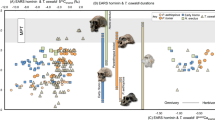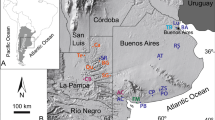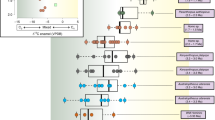Abstract
Analysis of enamel stable carbon isotopes (δ13Cenamel) of fossil herbivores is an important tool for making inferences about Plio-Pleistocene vegetation structure in Africa and the environmental context of hominin evolution. Many palaeoecological studies implicitly or explicitly assume that individual variation in C3–C4 plant consumption among fossil herbivores directly reflects the abundance of C3 (trees, shrubs) or C4 (low-altitude tropical grasses) vegetation. However, a strong link between δ13Cenamel of herbivores and ecosystem vegetation structure has not been rigorously established. Here we combine δ13Cenamel data from a large dataset (n = 1,643) with multidecadal Landsat estimates of C3 woody cover across 30 African ecosystems to show that there is little relationship between intrataxonomic variation in δ13Cenamel and vegetation structure. This is especially true when removing forested ecosystems (>80% woody cover)—which numerous lines of evidence suggest are rare in the Plio-Pleistocene fossil record of eastern Africa—from our analyses. Our findings stand in contrast with the common assumption that variation in herbivore δ13Cenamel values reflects changes in the relative abundance of C3–C4 vegetation. We conclude that analyses using herbivore δ13Cenamel data to shed light on the environmental context of hominin evolution should look to explicitly community-level approaches for making vegetation inferences.
This is a preview of subscription content, access via your institution
Access options
Access Nature and 54 other Nature Portfolio journals
Get Nature+, our best-value online-access subscription
$29.99 / 30 days
cancel any time
Subscribe to this journal
Receive 12 digital issues and online access to articles
$119.00 per year
only $9.92 per issue
Buy this article
- Purchase on Springer Link
- Instant access to full article PDF
Prices may be subject to local taxes which are calculated during checkout




Similar content being viewed by others
Data availability
All data generated or analysed during this study are included in this published article (and its Supplementary Information files). Source data are provided with this paper.
Code availability
The Google Earth Engine code used can be found at: https://code.earthengine.google.com/e3e1520a7b0fcd0c26ed567f6653a9a3.
References
Potts, R. Hominin evolution in settings of strong environmental variability. Quat. Sci. Rev. 73, 1–13 (2013).
Kingston, J. D. Shifting adaptive landscapes: progress and challenges in reconstructing early hominid environments. Am. J. Phys. Anthropol. 134, 20–58 (2007).
Levin, N. E. Environment and climate of early human evolution. Annu. Rev. Earth Planet. Sci. 43, 405–429 (2015).
Campisano, C. J. et al. The Hominin sites and Paleolakes Drilling Project: high-resolution paleoclimate records from the East African Rift system and their implications for understanding the environmental context of hominin evolution. PaleoAnthropology 2017, 1–43 (2017).
Lupien, R. L. et al. Vegetation change in the Baringo Basin, East Africa across the onset of Northern Hemisphere glaciation 3.3–2.6 Ma. Palaeogeogr. Palaeoclimatol. Palaeoecol. 570, 109426 (2019).
Yost, C. L. et al. Phytoliths, pollen, and microcharcoal from the Baringo Basin, Kenya reveal savanna dynamics during the Plio-Pleistocene transition. Palaeogeogr. Palaeoclimatol. Palaeoecol. 570, 109779 (2020).
Reed, K. E. Paleoecological patterns at the Hadar hominin site, Afar regional state, Ethiopia. J. Hum. Evol. 54, 743–768 (2008).
Kovarovic, K., Su, D. F., Lintulaakso, K. in Methods in Paleoecology (eds Croft, D. A., Su. D. F. & Simpson, S. W.) 351–372 (Springer, 2018).
Barr, W. A. in Methods in Paleoecology (eds Croft, D. A., Su. D. F. & Simpson, S. W.) 339–349 (Springer, 2018).
Fortelius, M. et al. An ecometric analysis of the fossil mammal record of the Turkana Basin. Philos. Trans. R. Soc. Lond. B 371, 20150232 (2016).
Polly, P. D. et al. History matters: ecometrics and integrative climate change biology. Proc. R. Soc. Lond. B 278, 1131–1140 (2011).
Wang, Y. & Cerling, T. E. A model of fossil tooth enamel and bone diagenesis: implications for stable isotope studies and paleoenvironment reconstruction. Palaeogeogr. Palaeoclimatol. Palaeoecol. 107, 281–289 (1994).
Bocherens, H., Koch, P. L., Mariotti, A., Geraads, D. & Jaeger, J. J. Isotopic biogeochemistry (13C, 18O) of mammalian enamel from African Pleistocene hominid sites. Palaios 11, 306–318 (1996).
Schoeninger, M. J., Reeser, H. & Hallin, K. Paleoenvironment of Australopithecus anamensis at Allia Bay, East Turkana, Kenya: evidence from mammalian herbivore enamel stable isotopes. J. Anthropol. Archaeol. 22, 200–207 (2003).
Levin, N. E., Simpson, S. W., Quade, J., Cerling, T. E. & Frost, S. R. Herbivore enamel carbon isotopic composition and the environmental context of Ardipithecus at Gona, Ethiopia. The geology of early humans in the Horn of Africa. Geol. Soc. Am. Spec. Pap. 446, 215–234 (2008).
Levin, N. E., Haile-Selassie, Y., Frost, S. R. & Saylor, B. Z. Dietary change among hominins and cercopithecids in Ethiopia during the early Pliocene. Proc. Natl Acad. Sci. USA 112, 12304–12309 (2015).
Kingston, J. D. in Paleontology and Geology of Laetoli: Human Evolution in Context (ed. Harrison, T.) 293–328 (Springer, 2011).
Cerling, T. E. et al. Dietary changes of large herbivores in the Turkana Basin, Kenya from 4 to 1 Ma. Proc. Natl Acad. Sci. USA 112, 11467–11472 (2015).
Wynn, J. G. et al. Dietary flexibility of Australopithecus afarensis in the face of paleoecological change during the middle Pliocene: faunal evidence from Hadar, Ethiopia. J. Hum. Evol. 99, 93–106 (2016).
Robinson, J. R., Rowan, J., Campisano, C. J., Wynn, J. G. & Reed, K. E. Late Pliocene environmental change during the transition from Australopithecus to Homo. Nat. Ecol. Evol. 1, 0159 (2017).
Ambrose, S. H. & DeNiro, M. J. The isotopic ecology of East African mammals. Oecologia 69, 395–406 (1986).
Cerling, T. E. & Harris, J. M. Carbon isotope fractionation between diet and bioapatite in ungulate mammals and implications for ecological and paleoecological studies. Oecologia 120, 347–363 (1999).
Sponheimer, M. et al. Diets of southern African Bovidae: stable isotope evidence. J. Mammal. 84, 471–479 (2003).
Tieszen, L. L., Senyimba, M. M., Imbaba, S. K. & Troughton, J. H. The distribution of C3 and C4 grasses and carbon isotope discrimination along an altitudinal and moisture gradient in Kenya. Oecologia 37, 337–350 (1979).
Tiezsen, L. L., Boutton, T., Tesdahl, K. & Slade, N. Fractionation and turnover of stable carbon isotopes in animal tissues: implications for the 13C analysis of diet. Oecologia 57, 32–37 (1983).
O’Leary, M. H. Carbon isotopes in photosynthesis. Bioscience 38, 328–336 (1988).
Kingdon, J. et al. Mammals of Africa Vol. 1 (A&C Black, 2013).
Kingston, J. D. & Harrison, T. Isotopic dietary reconstructions of Pliocene herbivores at Laetoli: implications for early hominin paleoecology. Palaeogeogr. Palaeoclimatol. Palaeoecol. 243, 272–306 (2007).
Patterson, D. B. et al. Comparative isotopic evidence from East Turkana supports a dietary shift within the genus Homo. Nat. Ecol. Evol. 3, 1048–1056 (2019).
Sponheimer, M. & Lee-Thorp, J. A. Using carbon isotope data of fossil bovid communities for palaeoenvironmental reconstruction: research articles: human origins research in South Africa. S. Afr. J. Sci. 99, 273–275 (2003).
Lee-Thorp, J. A., Sponheimer, M. & Luyt, J. Tracking changing environments using stable carbon isotopes in fossil tooth enamel: an example from the South African hominin sites. J. Hum. Evol. 53, 595–601 (2007).
Bedaso, Z., Wynn, J. G., Alemseged, Z. & Geraads, D. Paleoenvironmental reconstruction of the Asbole fauna (Busidima Formation, Afar, Ethiopia) using stable isotopes. Geobios 43, 165–177 (2010).
Bedaso, Z. K., Wynn, J. G., Alemseged, Z. & Geraads, D. Dietary and paleoenvironmental reconstruction using stable isotopes of herbivore tooth enamel from middle Pliocene Dikika, Ethiopia: implication for Australopithecus afarensis habitat and food resources. J. Hum. Evol. 64, 21–38 (2013).
Leichliter, J. N. et al. Small mammal insectivore carbon isotopes as environmental proxies in a South African savanna ecosystem. Am. J. Phys. Anthropol. 159, 206–207 (2016).
Codron, J. et al. Landscape-scale feeding patterns of African elephant inferred from carbon isotope analysis of feces. Oecologia 165, 89–99 (2011).
Marston, C. G. et al. ‘Remote’ behavioural ecology: do megaherbivores consume vegetation in proportion to its presence in the landscape? PeerJ 8, e8622 (2020).
Hernandez-Fernández, M. & Vrba, E. S. Plio-Pleistocene climatic change in the Turkana Basin (East Africa): evidence from large mammal faunas. J. Hum. Evol. 50, 595–626 (2006).
Lintulaakso, K. & Kovarovic, K. Diet and locomotion, but not body size, differentiate mammal communities in worldwide tropical ecosystems. Palaeogeogr. Palaeoclimatol. Palaeoecol. 454, 20–29 (2016).
Barr, W. A. Bovid locomotor functional trait distributions reflect land cover and annual precipitation in sub-Saharan Africa. Evol. Ecol. Res. 18, 253–269 (2017).
Eronen, J. T. et al. Precipitation and large herbivorous mammals I: estimates from present-day communities. Evol. Ecol. Res. 12, 217–233 (2010).
Eronen, J. T. et al. Precipitation and large herbivorous mammals II: application to fossil data. Evol. Ecol. Res. 12, 235–248 (2010).
Cerling, T. E. et al. Woody cover and hominin environments in the past 6 million years. Nature 476, 51–56 (2011).
White, T. D. et al. Macrovertebrate paleontology and the Pliocene habitat of Ardipithecus ramidus. Science 326, 67–93 (2009).
Venter, Z. S., Cramer, M. D. & Hawkins, H. J. Drivers of woody plant encroachment over Africa. Nat. Commun. 9, 2272 (2018).
Kohn, M. J. Carbon isotope compositions of terrestrial C3 plants as indicators of (paleo) ecology and (paleo) climate. Proc. Natl Acad. Sci. USA 107, 19691–19695 (2010).
Du, A., Robinson, J. R., Rowan, J., Lazagabaster, I. A. & Behrensmeyer, A. K. Stable carbon isotopes from paleosol carbonate and herbivore enamel document differing paleovegetation signals in the eastern African Plio-Pleistocene. Rev. Palaeobot. Palynol. 261, 41–52 (2019).
Brown, F. H., McDougall, I. & Gathogo, P. N. in The Paleobiology of Australopithecus (eds Reed, K. E. et al.) 7–20 (Springer, 2013).
McDougall, I. et al. New single crystal 40Ar/39Ar ages improve time scale for deposition of the Omo Group, Omo–Turkana Basin, East Africa. J. Geol. Soc. 169, 213–226 (2012).
Herries, A. I. et al. in The Paleobiology of Australopithecus (eds Reed, K. E., Fleagle, J. G. & Leakey, R. E.) 21–40 (Springer, 2013).
Pickering, R. et al. U–Pb-dated flowstones restrict South African early hominin record to dry climate phases. Nature 565, 226–229 (2019).
Erena, M. G., Bekele, A. & Debella, H. J. Diet composition of forest inhabiting Cape buffalo (Syncerus caffer caffer) in western Ethiopia. Int. J. Ecol. Environ. Sci. 45, 165–178 (2019).
Pianka, E. R. in Theoretical Ecology. Principles and Applications (ed. May, R. M.) 114–141 (Blackwell Scientific, 1976).
Schoener, T. W. The controversy over interspecific competition: despite spirited criticism, competition continues to occupy a major domain in ecological thought. Am. Sci. 70, 586–595 (1982).
Gordon, I. J. & Prins, H. H. T. in The Ecology of Browsing and Grazing (eds Gordon, I. J. & Prins, H. H. T.) 309–321 (Springer, 2008).
O’Kane, C. A., Duffy, K. J., Page, B. R. & Macdonald, D. W. Effects of resource limitation on habitat usage by the browser guild in Hluhluwe-iMfolozi Park, South Africa. J. Trop. Ecol. 29, 39–47 (2013).
Codron, J. et al. Taxonomic, anatomical, and spatio-temporal variations in the stable carbon and nitrogen isotopic compositions of plants from an African savanna. J. Archaeol. Sci. 32, 1757–1772 (2005).
Codron, D., Codron, J., Lee-thorp, A. J., Sponheimer, M. & Brink, S. J. Dietary variation in impala Aepyceros melampus recorded by carbon isotope composition of feces. Acta Zool. Sin. 52, 1015–1025 (2006).
Uno, K. T. et al. High-resolution stable isotope profiles of modern elephant (Loxodonta africana) tusk dentin and tail hair from Kenya: implications for identifying seasonal variability in climate, ecology, and diet in ancient proboscideans. Palaeogeogr. Palaeoclimatol. Palaeoecol. 559, 109962 (2020).
Uno, K. T., Polissar, P. J., Jackson, K. E. & deMenocal, P. B. Neogene biomarker record of vegetation change in eastern Africa. Proc. Natl Acad. Sci. USA 113, 6355–6363 (2016).
Owen-Smith, R. N. Megaherbivores: The Influence of Very Large Body Size on Ecology (Cambridge Univ. Press, 1988).
Uno, K. T. et al. Forward and inverse methods for extracting climate and diet information from stable isotope profiles in proboscidean molars. Quat. Intern. 557, 92–109 (2020).
White, F. The Vegetation of Africa: A Descriptive Memoir to Accompany the UNESCO/AETFAT/UNSO Vegetation Map of Africa (3 plates), 1:5,000,000 (UNESCO, 1983).
Uno, K. T. et al. A Pleistocene palaeovegetation record from plant wax biomarkers from the Nachukui Formation, West Turkana, Kenya. Philos. Trans. R. Soc. Lond. B 371, 20150235 (2016).
Behrensmeyer, A. K., Kidwell, S. M. & Gastaldo, R. A. Taphonomy and paleobiology. Paleobiology 26, 103–147 (2000).
Faith, J. T., Du, A. & Rowan, J. Addressing the effects of sampling on ecometric-based paleoenvironmental reconstructions. Palaeogeogr. Palaeoclimatol. Palaeoecol 528, 175–185 (2019).
Shorrocks, B. & Bates, W. The Biology of African Savannahs (Oxford Univ. Press, 2015).
Tieszen, L. L. Natural variations in the carbon isotope values of plants: implications for archaeology, ecology, and paleoecology. J. Archaeol. Sci. 18, 227–248 (1991).
Cornwell, W. K. et al. Climate and soils together regulate photosynthetic carbon isotope discrimination within C3 plants worldwide. Glob. Ecol. Biogeogr. 27, 1056–1067 (2018).
Luyt, J., Hare, V. J. & Sealy, J. The relationship of ungulate δ13C and environment in the temperate biome of southern Africa, and its palaeoclimatic application. Palaeogeogr. Palaeoclimatol. Palaeoecol. 514, 282–291 (2019).
Protected Planet: The World Database on Protected Areas (WDPA) (UNEP-WCMC and IUCN, 2020); www.protectedplanet.net
ArcGIS Desktop Release 10 (Environmental Systems Research Institute, 2012).
Ogutu, J. et al. Changing wildlife populations in Nairobi national park and adjoining Athi-Kaputiei plains: collapse of the migratory wildebeest. Open Conserv. Biol. J. 7, 11–26 (2013).
Forest Atlas of the Democratic Republic of the Congo (Ministry of Environment and Sustainable Development of the Democratic Republic of the Congo and World Resources Institute, 2020); https://www.wri.org/resources/maps/forest-atlas-democratic-republic-congo
R: A Language and Environment for Statistical Computing (R Foundation for Statistical Computing, 2019); https://www.R-project.org/
Wickham, H. ggplot2: Elegant Graphics for Data Analysis (Springer, 2016).
Author information
Authors and Affiliations
Contributions
J.R.R. and J.R. were responsible for the conceptualization of the study and writing the original draft. J.R.R., J.R. and W.A.B. were responsible for the visualization of the study. J.R.R., J.R., W.A.B., M.S. undertook the formal analysis. All authors were responsible for the methodology and contributed to and approved the final version of the manuscript.
Corresponding author
Ethics declarations
Competing interests
The authors declare no competing interests.
Additional information
Peer review information Nature Ecology & Evolution thanks Michaela Ecker and the other, anonymous, reviewer(s) for their contribution to the peer review of this work. Peer reviewer reports are available.
Publisher’s note Springer Nature remains neutral with regard to jurisdictional claims in published maps and institutional affiliations.
Extended data
Extended Data Fig. 1 Removing high elevation ecosystems.
Relationship between δ13Cenamel values and mean woody cover across African herbivore taxa excluding high elevation ecosystems (those spanning > 2000 m). Gray line and 95% confidence intervals show the linear fit.
Extended Data Fig. 2 Removing forested ecosystems.
Relationship between δ13Cenamel values and mean woody cover across African herbivore taxa excluding habitats with ≤80% mean woody cover. Gray line and 95% confidence intervals show the linear fit.
Extended Data Fig. 3 Proposed community approach.
Relationship between community δ13C values and mean woody cover across twenty-two African ecosystems (A). Gray line and 95% confidence intervals show linear (B) and quadratic (C) fits.
Supplementary information
Supplementary Information
Supplementary discussion, Tables 1–6 and references.
Supplementary Data 1
Recent carbon isotopic data from 30 African ecosystems used in these analyses (a subset of data from Cerling et al. 2015), and recent carbon isotopic data used for preliminary community analyses.
Source data
Source Data Fig. 1
Lat/Long data for study site locations (Statistical Source Data).
Source Data Fig. 2
Woody cover means and standard deviations (Statistical Source Data).
Source Data Fig. 3
Woody cover and carbon isotope values (Statistical Source Data).
Source Data Fig. 4
Paleosol counts (a) and slope values (b) (Statistical Source Data).
Source Data Extended Data Fig. 1
Woody cover and carbon isotope values without high elevation ecosystems (Statistical Source Data).
Source Data Extended Data Fig. 2
Woody cover and carbon isotope values without forested ecosystems (Statistical Source Data).
Source Data Extended Data Fig. 3
Community carbon isotope measure and woody cover for twenty-two modern ecosystems (Statistical Source Data).
Rights and permissions
About this article
Cite this article
Robinson, J.R., Rowan, J., Barr, W.A. et al. Intrataxonomic trends in herbivore enamel δ13C are decoupled from ecosystem woody cover. Nat Ecol Evol 5, 995–1002 (2021). https://doi.org/10.1038/s41559-021-01455-7
Received:
Accepted:
Published:
Issue Date:
DOI: https://doi.org/10.1038/s41559-021-01455-7



